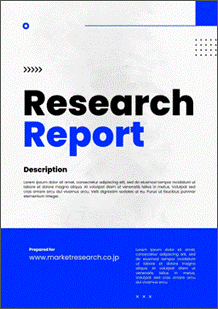 | • レポートコード:MRC2303B025 • 出版社/出版日:Mordor Intelligence / 2023年1月 • レポート形態:英文、PDF、150ページ • 納品方法:Eメール(受注後2-3営業日) • 産業分類:農業 |
| Single User | ¥655,500 (USD4,750) | ▷ お問い合わせ |
| Corporate License | ¥1,207,500 (USD8,750) | ▷ お問い合わせ |
• お支払方法:銀行振込(納品後、ご請求書送付)
レポート概要
| Mordor Intelligence社の本市場調査レポートでは、世界の農業廃水処理市場規模が、2021年に2,100百万ドルに達し、予測期間中(2022年~2027年)に年平均4%で成長すると展望しています。本書は、農業廃水処理の世界市場について総合的に分析し、イントロダクション、調査手法、エグゼクティブサマリー、市場動向、技術別(物理的手段、化学的手段、生物学的手段)分析、汚染源別(点源、非点源)分析、用途別(作物、非作物)分析、地域別(中国、インド、日本、韓国、東南アジア、アメリカ、カナダ、メキシコ、ドイツ、イギリス、フランス、イタリア、ブラジル、アルゼンチン、サウジアラビア、南アフリカ)分析、競争状況、市場機会・将来の動向などの項目を整理しています。さらに、参入企業として、AECOM、Aquatech International LLC、BASF SE、DuPont、Evoqua Water Technologies、IDE Technologies、Jacobs、Lindsay Corporation、Louis Berger、Nouryon、Organo Corporation、Origin clear Inc.、Suez SA、Veolia Environnement SAなどの情報を含んでいます。 ・イントロダクション ・調査手法 ・エグゼクティブサマリー ・市場動向 ・世界の農業廃水処理市場規模:技術別 - 物理的手段における市場規模 - 化学的手段における市場規模 - 生物学的手段における市場規模 ・世界の農業廃水処理市場規模:汚染源別 - 点源における市場規模 - 非点源における市場規模 ・世界の農業廃水処理市場規模:用途別 - 作物における市場規模 - 非作物における市場規模 ・世界の農業廃水処理市場規模:地域別 - アジア太平洋の農業廃水処理市場規模 中国の農業廃水処理市場規模 インドの農業廃水処理市場規模 日本の農業廃水処理市場規模 … - 北米の農業廃水処理市場規模 アメリカの農業廃水処理市場規模 カナダの農業廃水処理市場規模 メキシコの農業廃水処理市場規模 … - ヨーロッパの農業廃水処理市場規模 ドイツの農業廃水処理市場規模 イギリスの農業廃水処理市場規模 イタリアの農業廃水処理市場規模 … - 南米/中東の農業廃水処理市場規模 ブラジルの農業廃水処理市場規模 アルゼンチンの農業廃水処理市場規模 サウジアラビアの農業廃水処理市場規模 … - その他地域の農業廃水処理市場規模 ・競争状況 ・市場機会・将来の動向 |
The agricultural wastewater treatment market was estimated to be more than USD 2,100 million in 2021, registering a CAGR of more than 4% during the forecast period (2022-2027).
The COVID-19 pandemic affected the market negatively. However, the market is expected to grow steadily during the forecast period.
Key Highlights
- Rapidly diminishing freshwater resources and rising agricultural water demand are likely to drive the demand for the studied market.
- On the flip side, a dearth of awareness regarding agriculture wastewater treatment is expected to hinder the market growth.
- Growing investments and active research on water treatment technologies are expected to provide a major growth opportunity for the market studied.
- Asia-Pacific accounted for the highest share of the market and is likely to continue dominating the market during the forecast period.
Agricultural Wastewater Treatment Market Trends
Non-Crop Segment to Dominate the Market
- Non-crop is by far the largest application for agricultural wastewater treatment across the world and is increasing at a steady rate.
- This segment primarily includes feed production and also dairy farms and poultry. Despite low calorie and protein supply as compared to plant-based food, livestock, meat, and dairy still hold the largest share in terms of consumption.
- This scenario, in turn, is boosting the demand for water treatment applications in the non-crop sector.
- Asia-Pacific is the second-most active region for processed food globally in terms of poultry. New product development (NPD) accounts for 24% of processed meat, poultry, and fish product innovations in the region, led by China, Thailand, South Korea, Vietnam, and the Philippines.
- African swine fever (ASF) further stimulated chicken expansion in Asia in 2020. Southeast Asia’s poultry production expanded by 56% in the last decade, growing from 5.9 million metric tons (mmt) to 9.2 mmt in 2018. It is expected to reach 12.3 mmt by 2028.
- According to FAO, the demand for dairy products has exhibited positive signs after a slowdown due to the COVID-19 pandemic.
- Hence, the non-crop segment is expected to dominate the market in the forecast period.
China to Dominate the Asia-Pacific Market
- China accounts for approximately 7% of the overall agricultural acreage globally, thus feeding 22% of the world population. The country is the largest producer of various crops, including rice, cotton, potatoes, and other vegetables. Hence, the demand for agricultural wastewater treatment is rapidly increasing in the country.
- The population of China has grown at a staggering rate in the past decade, and more than half of the population now live in cities. With the government promoting economic growth, urbanization is on the rise. This is expected to increase the demand for improvement in agricultural wastewater infrastructure.
- In 2022, chicken meat production in China is expected to exceed 2021 as prices rebound, demand boosts national consumption, and new facilities expand production capacity. The resultant growth is expected to be around 20%.
- Meanwhile, total exports of chicken meat to China are forecast to grow by 4% next year.
- In 2021, farmers in China produced around 212.84 million metric tons of rice. At the same time, the production volume of wheat amounted to approximately 136.95 million metric tons in China. The production volume of rice, wheat, and corn in China increased continuously until 2015, remained flat thereafter, but grew again in 2021.
- Based on the aforementioned aspects, China is expected to dominate the Asia-Pacific region.
Agricultural Wastewater Treatment Market Competitor Analysis
The agriculture wastewater treatment market is fragmented, with the presence of majorly multinational players. Some of the major players in the market (in no particular order) include Veolia Environnement SA, Suez SA, Evoqua Water Technologies LLC, DuPont, and Jacobs.
Additional Benefits:
- The market estimate (ME) sheet in Excel format
- 3 months of analyst support
1 INTRODUCTION
1.1 Study Assumptions
1.2 Scope of the Study
2 RESEARCH METHODOLOGY
3 EXECUTIVE SUMMARY
4 MARKET DYNAMICS
4.1 Drivers
4.1.1 Rapidly Diminishing Fresh Water Resources
4.1.2 Rising Agricultural Water Demand
4.2 Restraints
4.2.1 Dearth of Awareness regarding Agriculture Wastewater Treatment
4.2.2 Other Restraints
4.3 Industry Value Chain Analysis
4.4 Porter’s Five Forces Analysis
4.4.1 Bargaining Power of Suppliers
4.4.2 Bargaining Power of Consumers
4.4.3 Threat of New Entrants
4.4.4 Threat of Substitute Products and Services
4.4.5 Degree of Competition
5 MARKET SEGMENTATION
5.1 Technology
5.1.1 Physical Solutions
5.1.2 Chemical Solutions
5.1.3 Biological Solutions
5.2 Pollutant Source
5.2.1 Point Source
5.2.2 Nonpoint Source
5.3 Application
5.3.1 Crop
5.3.2 Non-crop
5.4 Geography
5.4.1 Asia-Pacific
5.4.1.1 China
5.4.1.2 India
5.4.1.3 Japan
5.4.1.4 South Korea
5.4.1.5 ASEAN Countries
5.4.1.6 Rest of Asia-Pacific
5.4.2 North America
5.4.2.1 United States
5.4.2.2 Canada
5.4.2.3 Mexico
5.4.3 Europe
5.4.3.1 Germany
5.4.3.2 United Kingdom
5.4.3.3 France
5.4.3.4 Italy
5.4.3.5 Rest of Europe
5.4.4 South America
5.4.4.1 Brazil
5.4.4.2 Argentina
5.4.4.3 Rest of South America
5.4.5 Middle-East
5.4.5.1 Saudi Arabia
5.4.5.2 South Africa
5.4.5.3 Rest of Middle-East
6 COMPETITIVE LANDSCAPE
6.1 Mergers and Acquisitions, Joint Ventures, Collaborations, and Agreements
6.2 Market Share(%)**/Ranking Analysis
6.3 Strategies Adopted by Leading Players
6.4 Company Profiles
6.4.1 AECOM
6.4.2 Aquatech International LLC
6.4.3 BASF SE
6.4.4 DuPont
6.4.5 Evoqua Water Technologies
6.4.6 IDE Technologies
6.4.7 Jacobs
6.4.8 Lindsay Corporation
6.4.9 Louis Berger
6.4.10 Nouryon
6.4.11 Organo Corporation
6.4.12 Origin clear Inc.
6.4.13 Suez SA
6.4.14 Veolia Environnement SA
7 MARKET OPPORTUNITIES AND FUTURE TRENDS
7.1 Growing Investments and Active Research on Water Treatment Technologies
